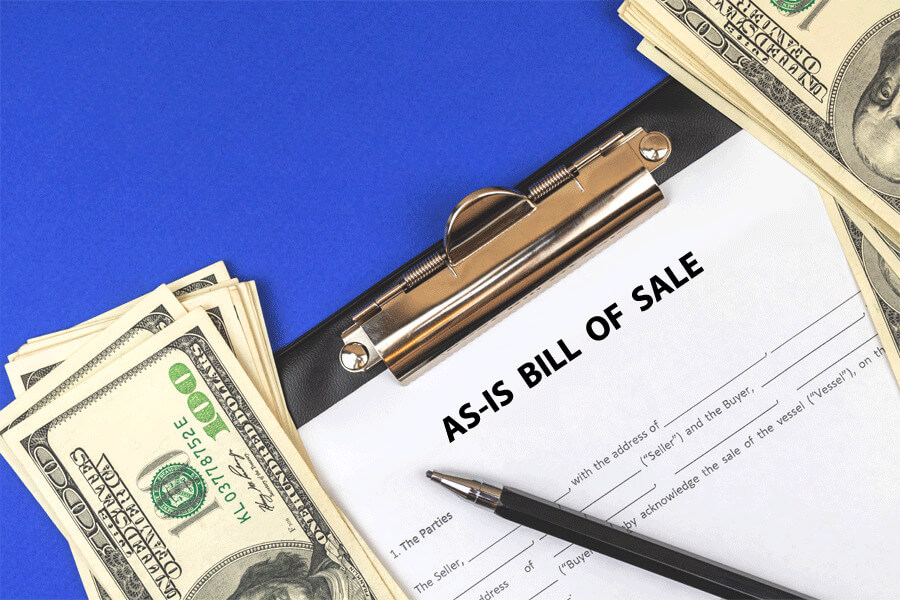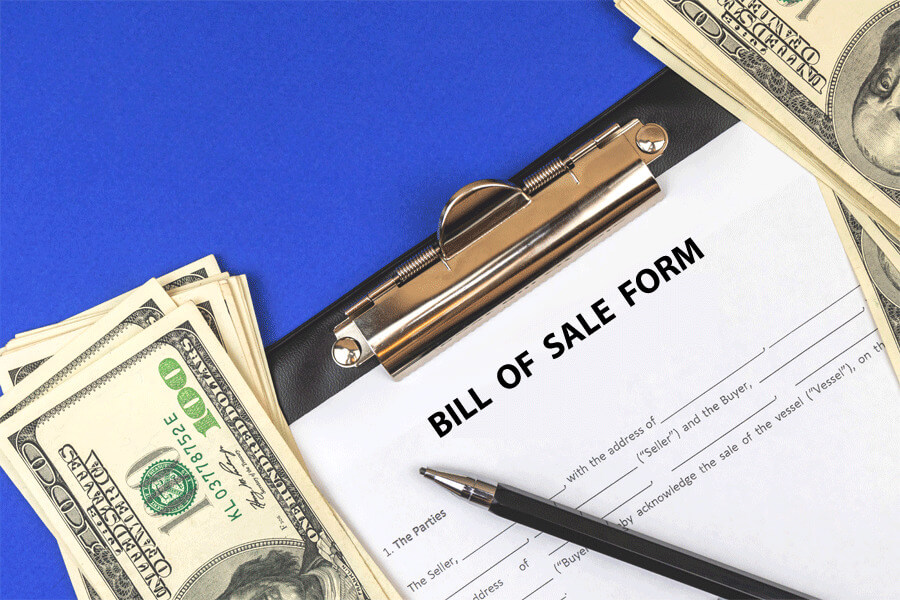Bill of sale is a legal document used to transfer the possession of an item from one party to another. A Bill of Sale Form is a predefined form that you can fill to complete a sale.
This form is similar to a store receipt but is used to record the purchase and sale of expensive items such as a vehicle. This form can also be used to transfer ownership of items such as boats, private property, jewellery, equipment, ammunition, and animals such as dogs or cats.
A bill of sale is a contract between two parties to sell property in exchange for money. It is usually signed after the transaction has been completed. For registration purposes, the buyer should retain an original signed copy of this form. Depending on the state, either the buyer or the seller would be responsible for collecting and paying sales taxes.
Free Bill of Sale Forms
Bill of Sale Forms by State
Bill of Sale Forms by Type
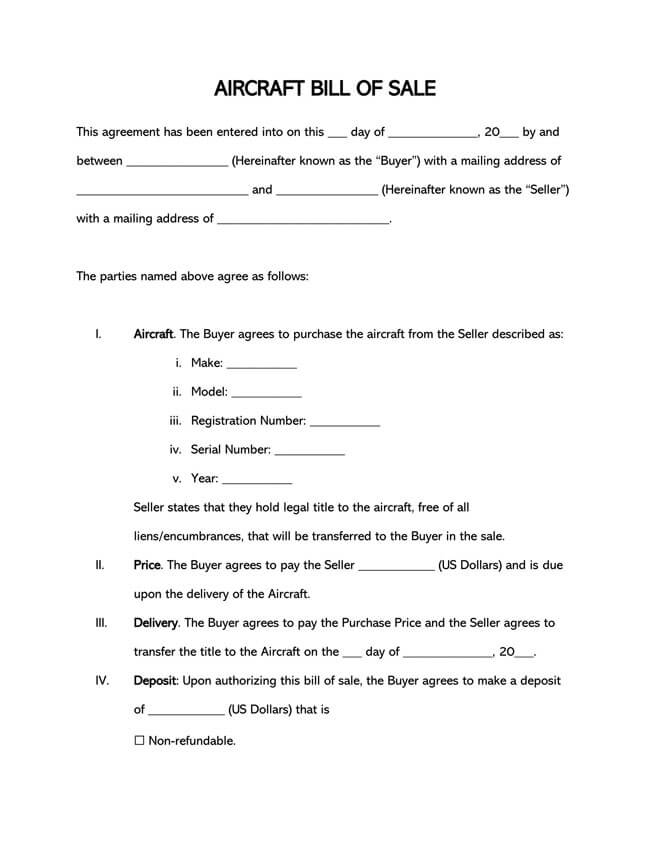
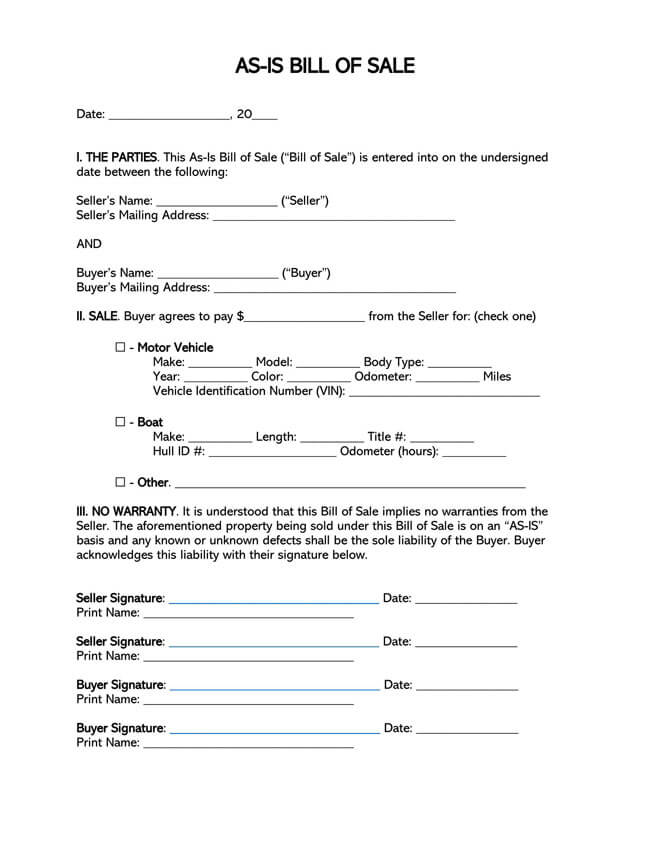
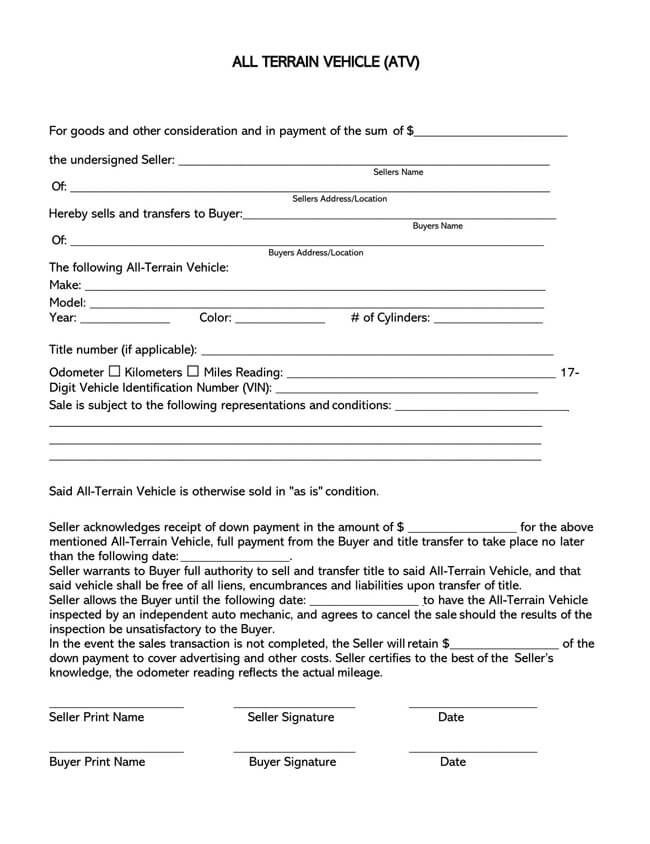
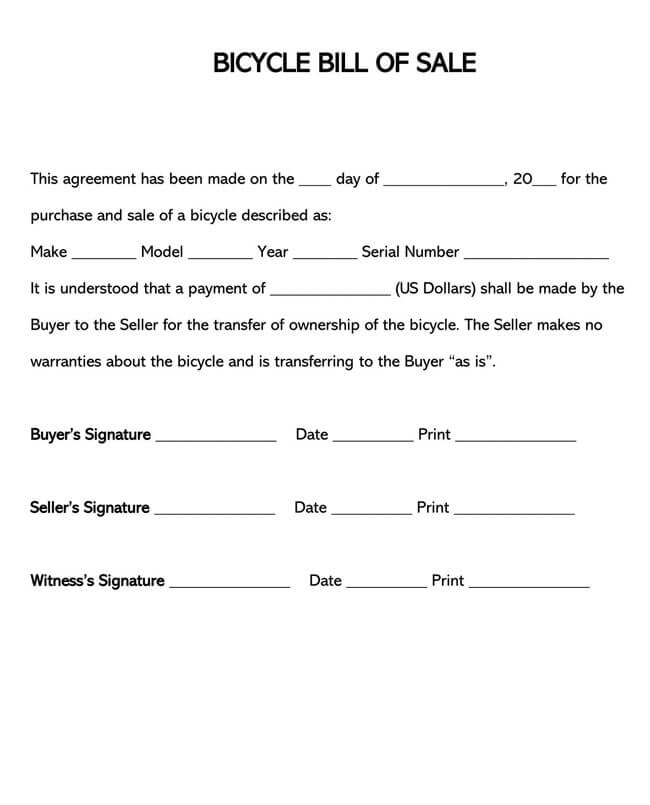

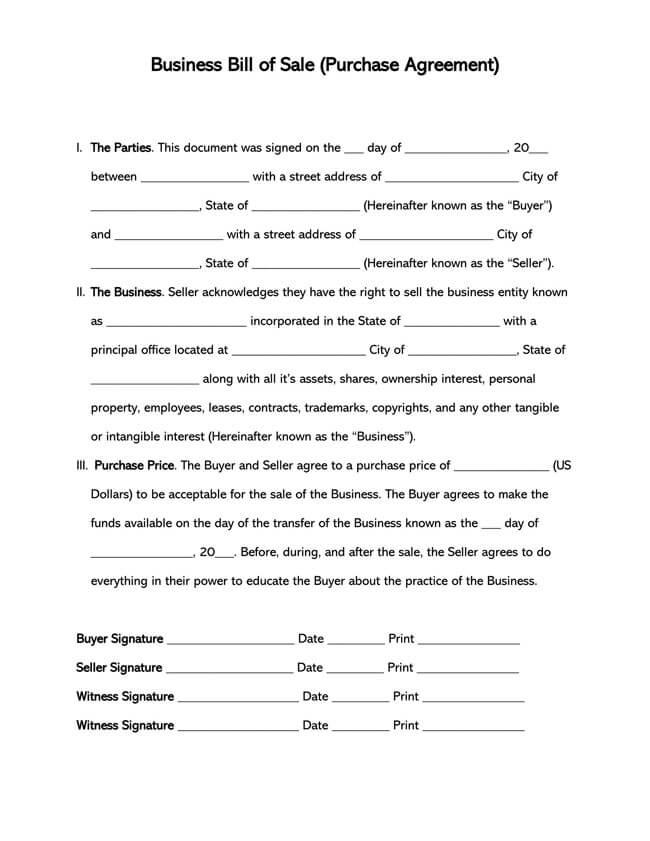
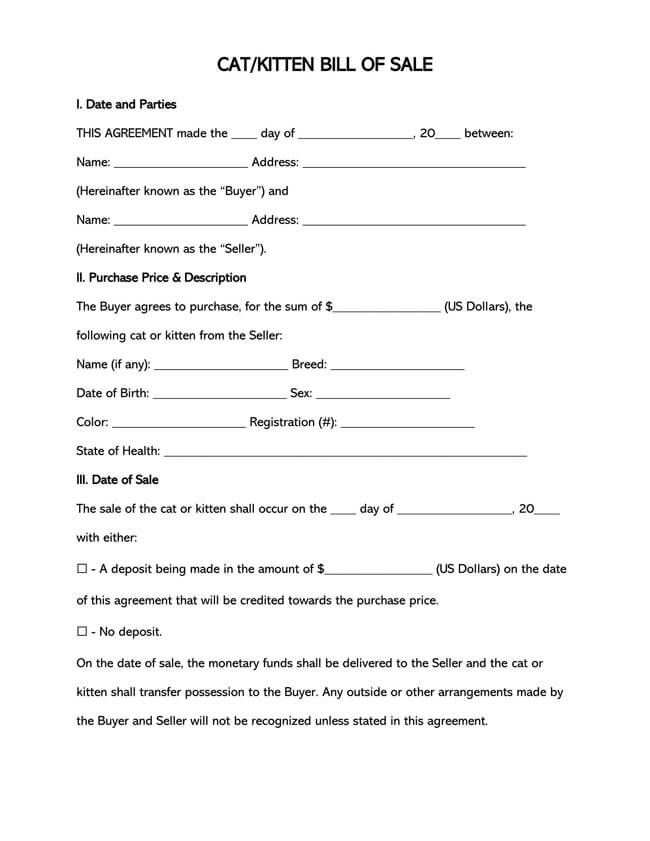
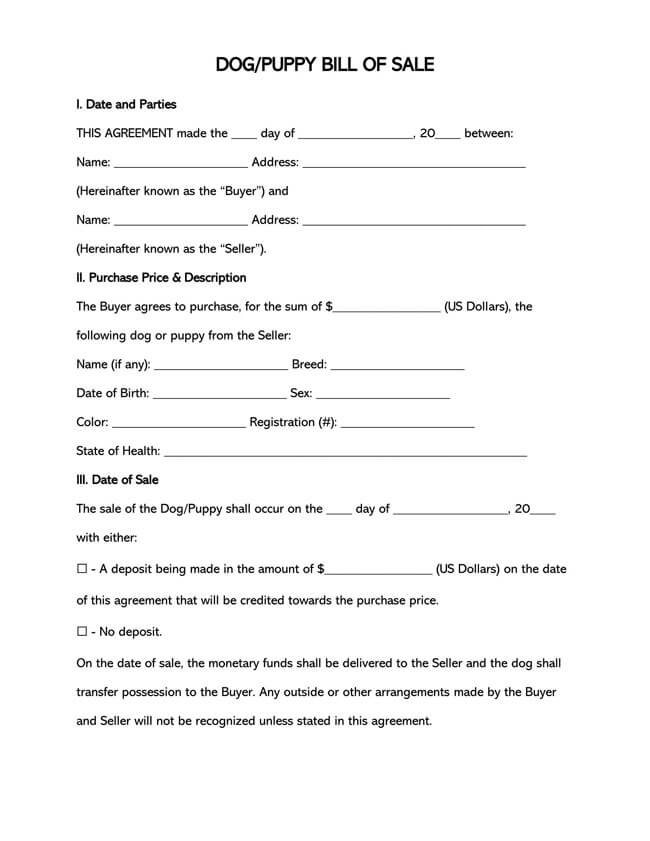
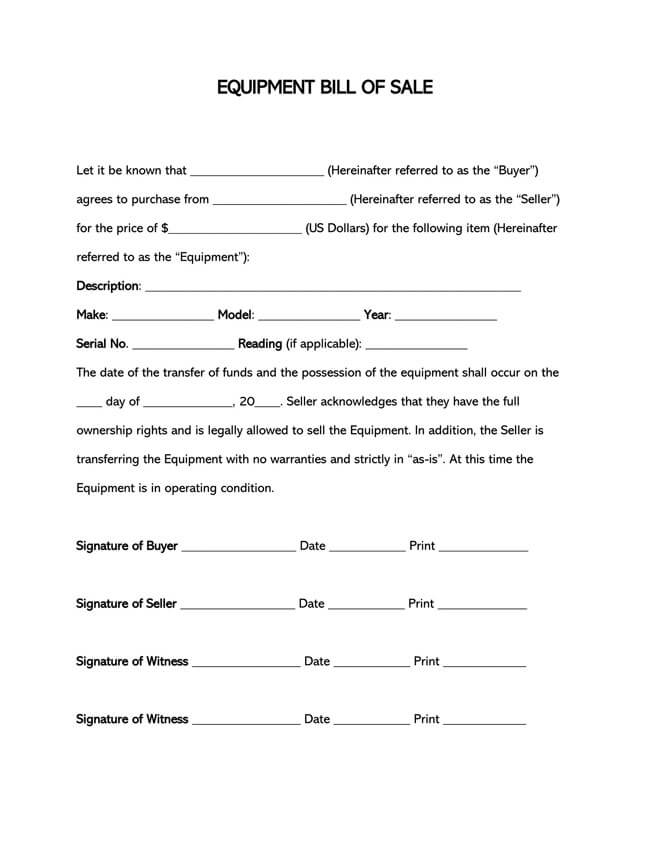
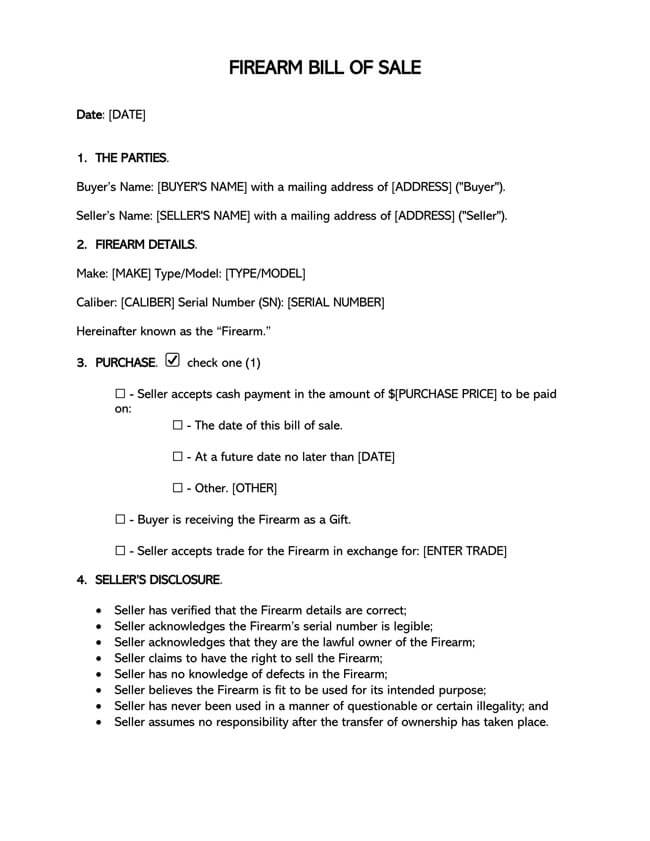
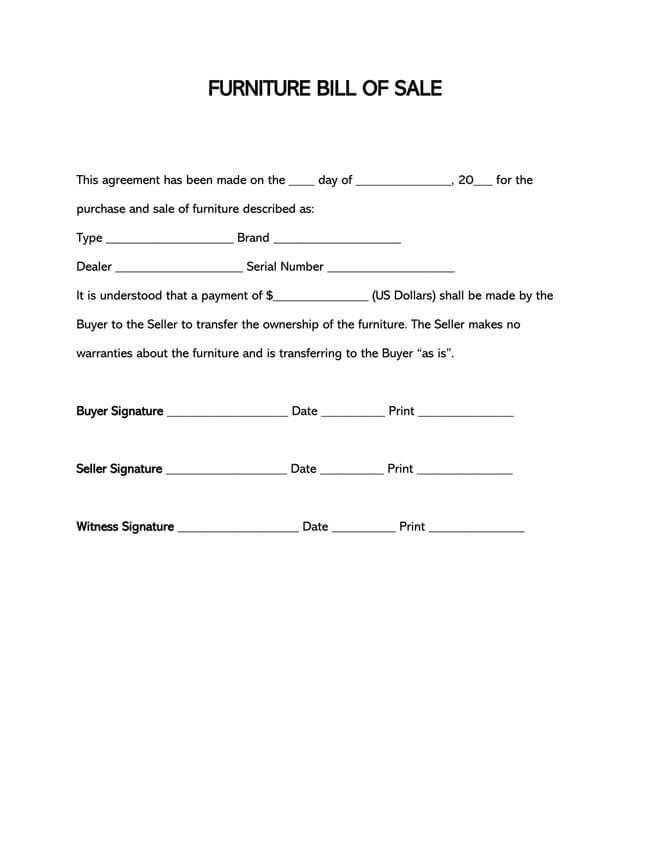
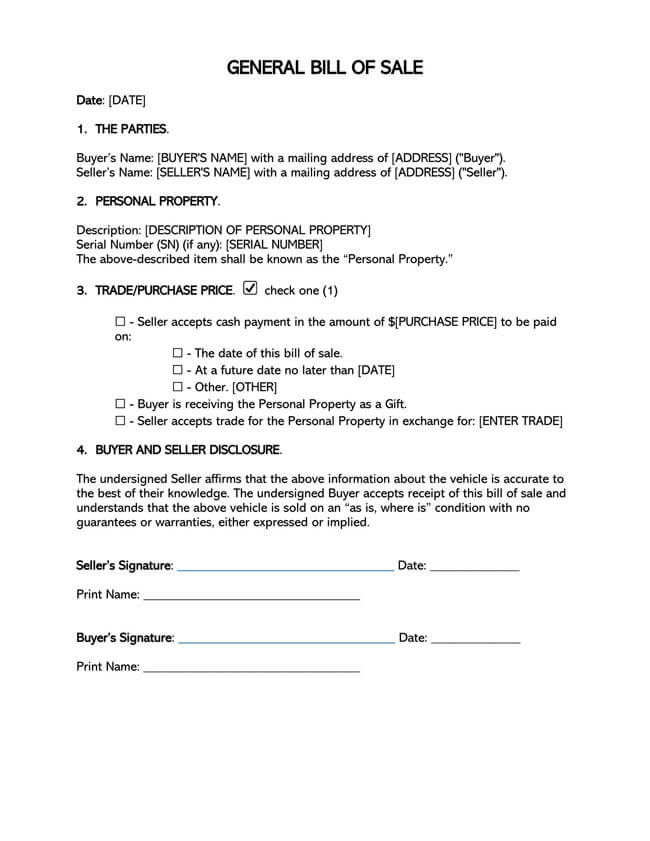
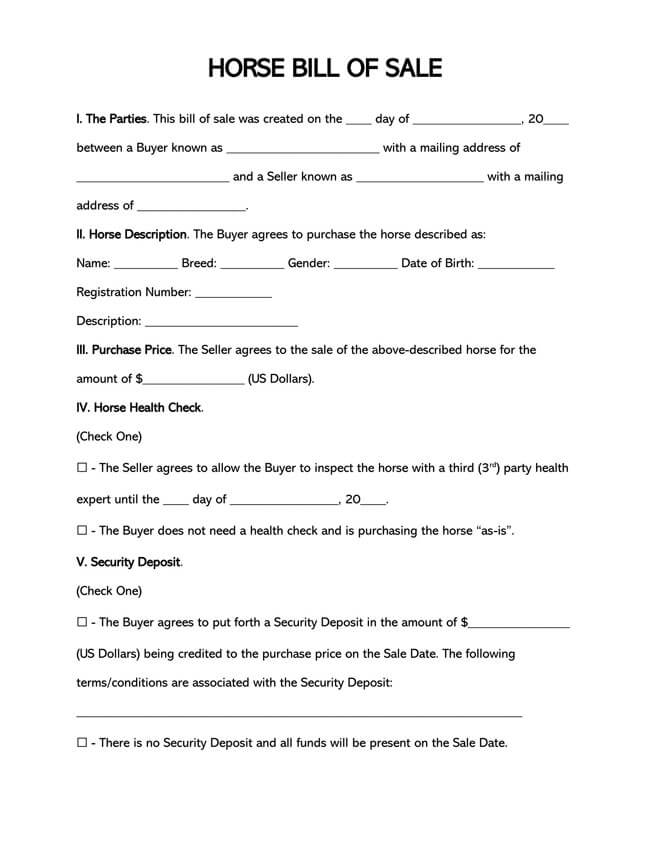
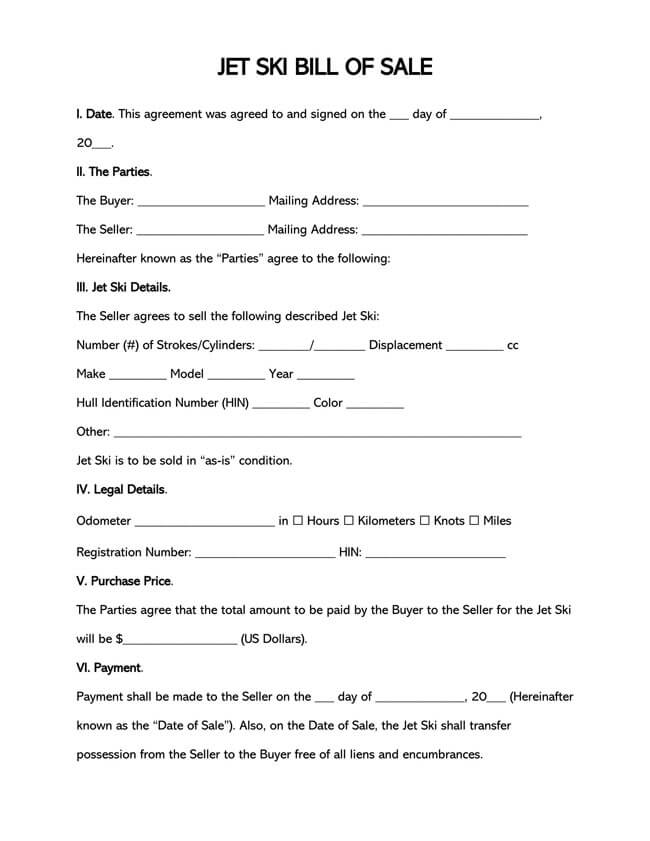
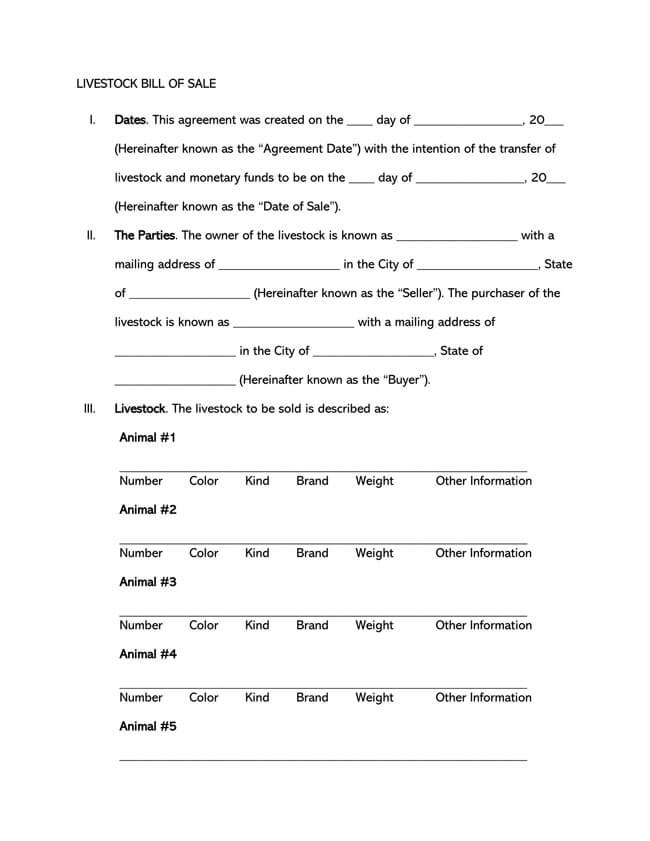
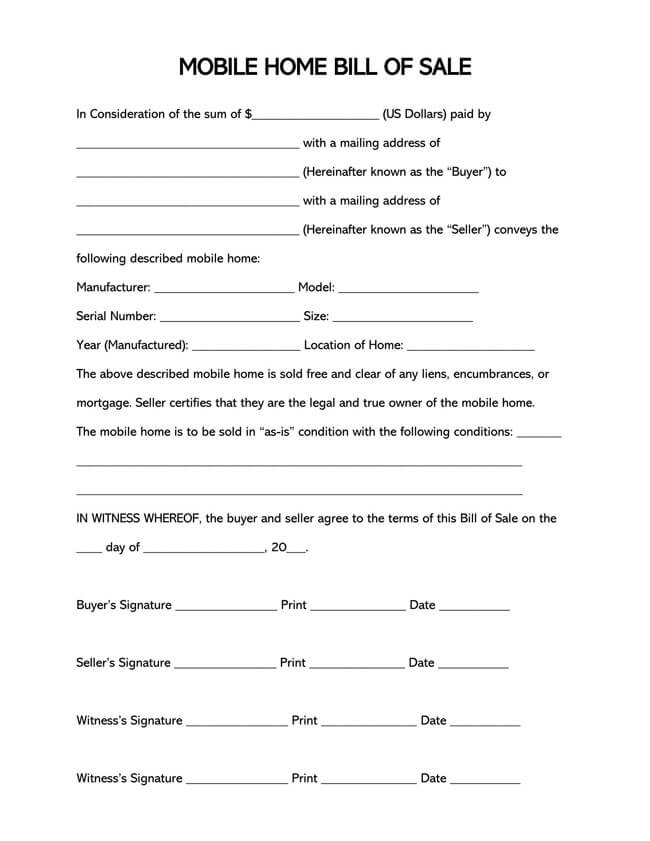
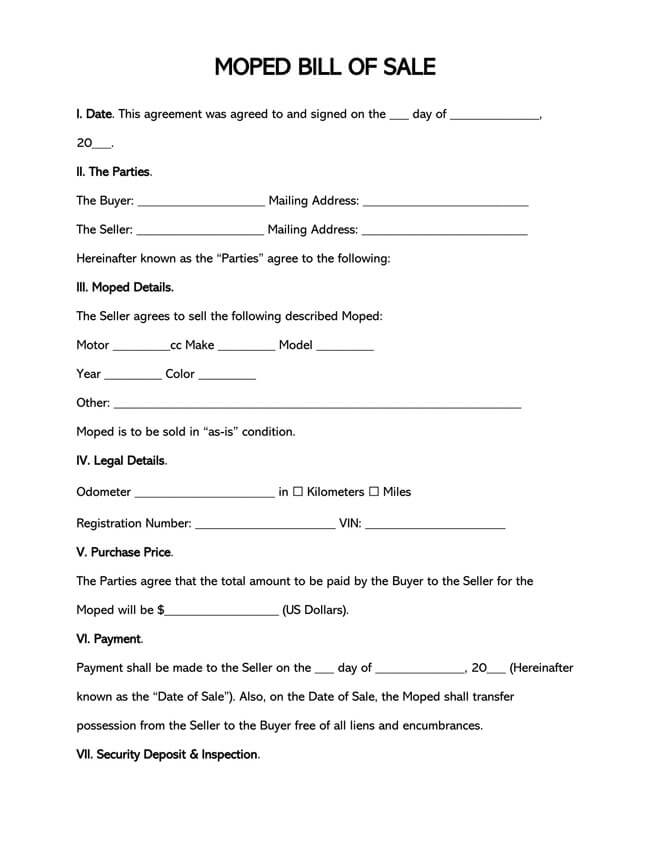
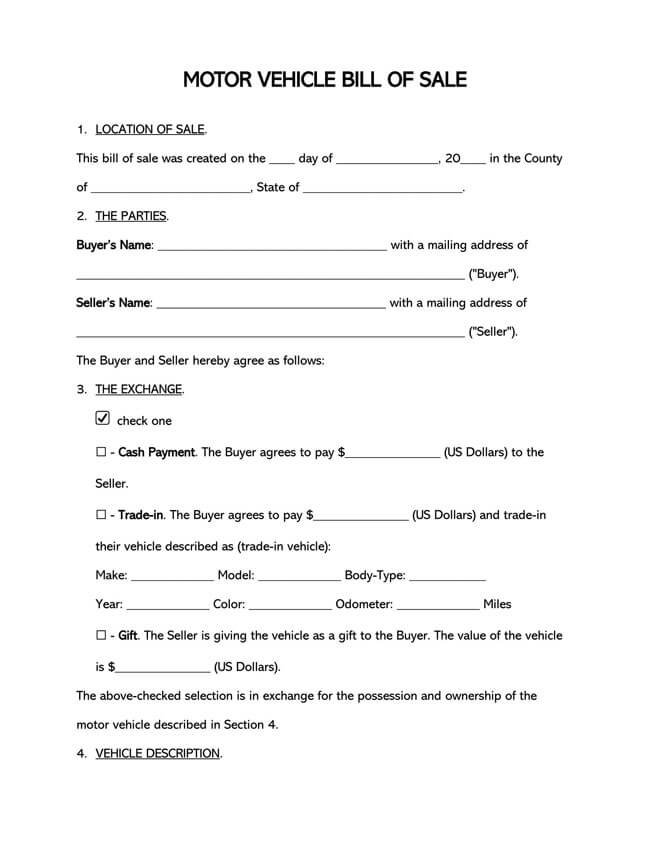
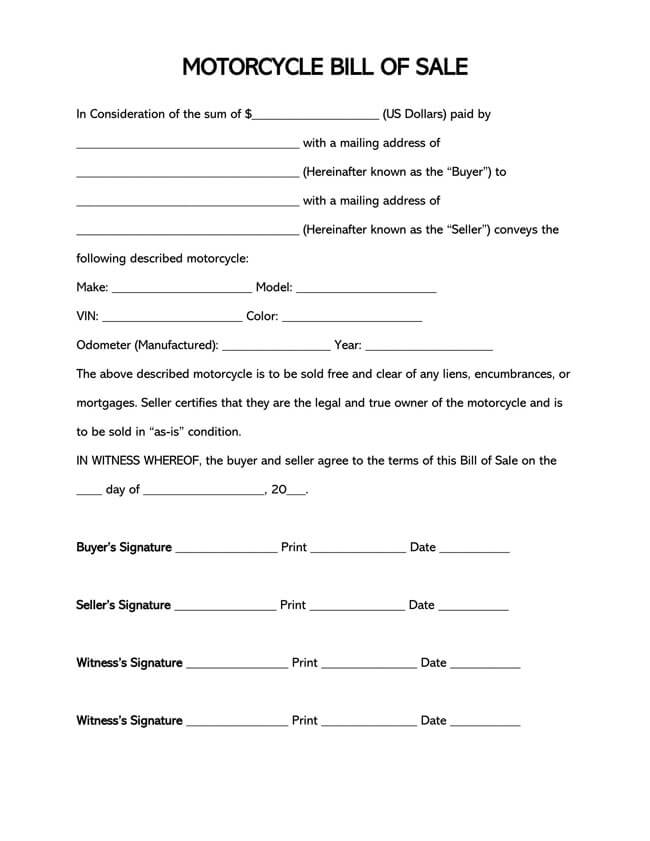
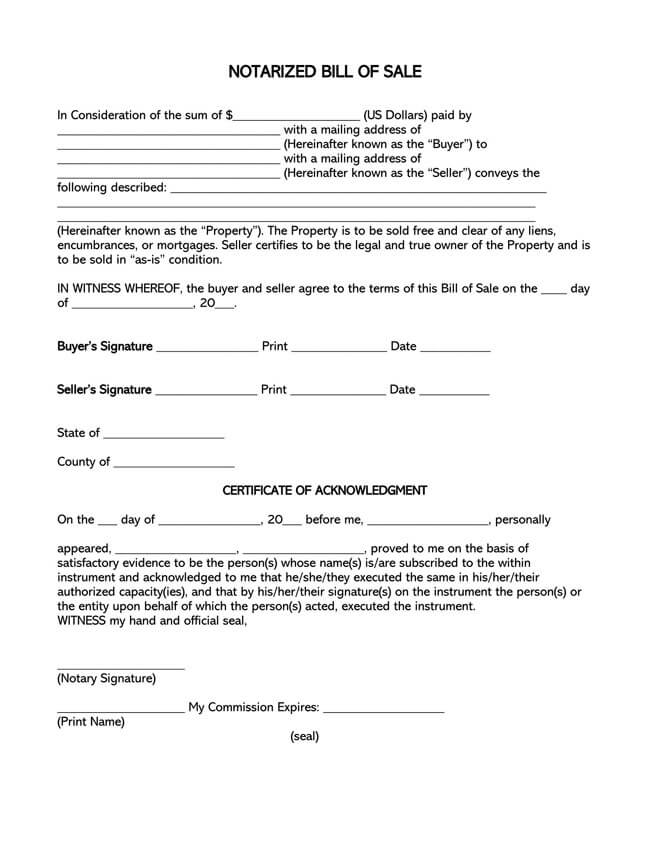
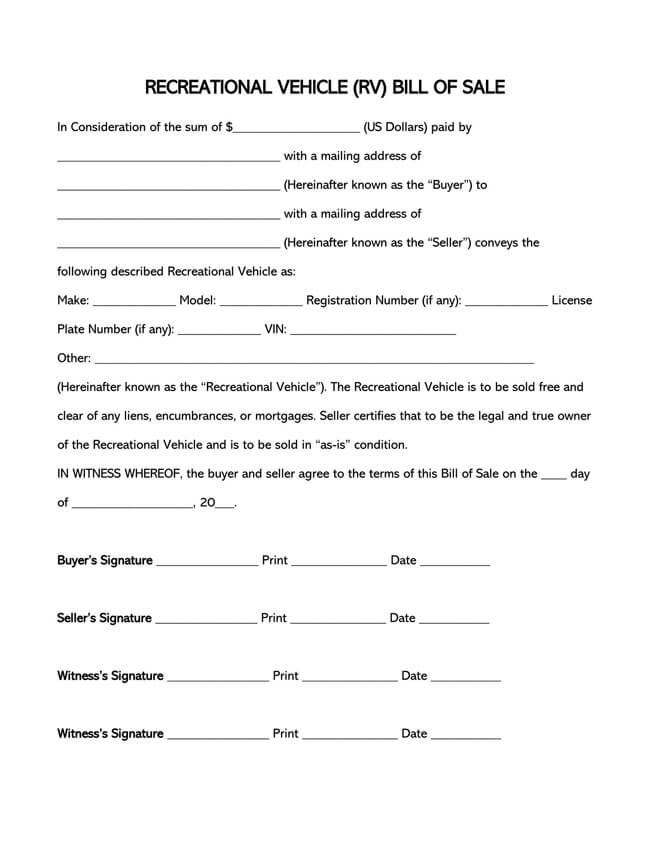
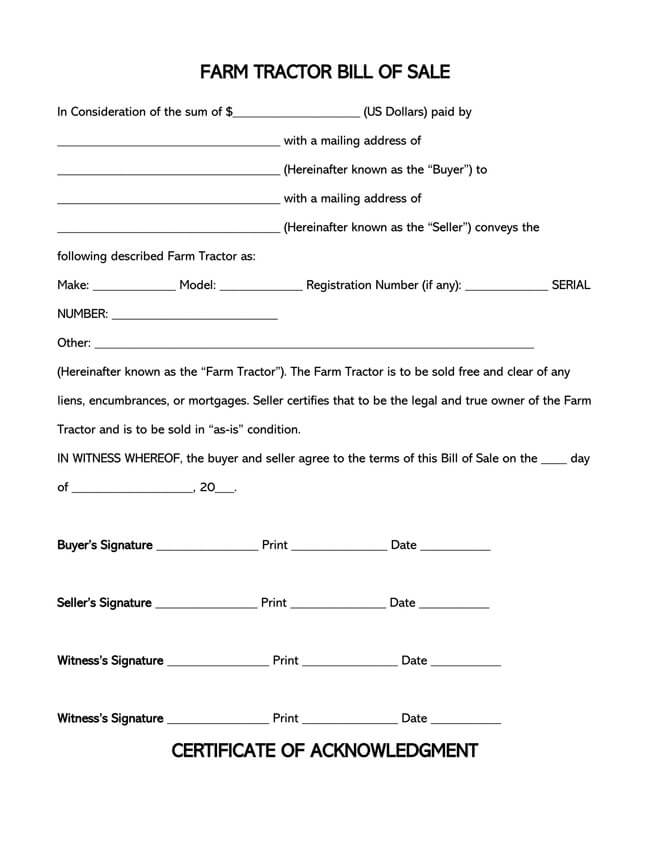
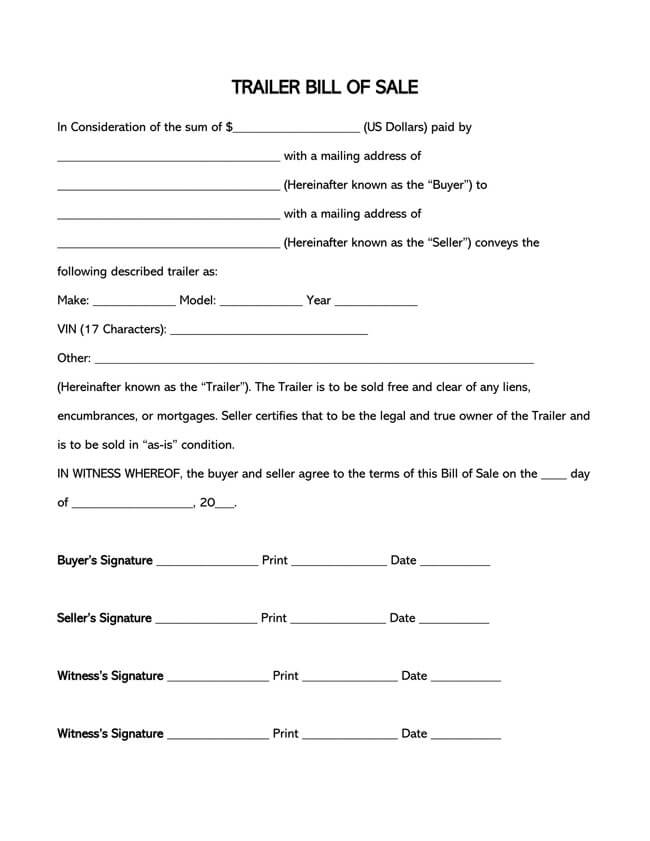
Glossary for the Bill of Sale Form
It is essential to understand the legal terms of form, such as the “as-is” clause, notary public, the buyer, payments, etc., before filling out a bill of sale. After knowing what these terms mean, writing this form will become an easy task. In this section of the article, we have explained what these legal terms mean for easier understanding.
- “As-is” – The phrase “as-is” means that the item is sold in its current state at the time of sale, and the buyer acknowledges any defects that exist.
- The buyer/purchaser – The buyer or the purchaser is the person who is buying the item. They are sometimes regarded as the purchaser.
- Gift – The act of giving a product to a “buyer” without receiving anything in return.
- Notary public – A notary public is a state-appointed official who notarizes documents. A notary public is found at the local bank or via a specialist service.
- Certificate of title – A certificate of title is a separate document stating who is the legal owner of an item. A certificate of title should be transferred after the sale is completed. It is important to note that a bill of sale confirms the transaction occurred, but it is not necessarily an indication of ownership.
- Payment – In a transaction, it is the money that is used to pay for an object.
- Seller – A seller is the person/party who is selling the item.
- Trade-in – A trade-in is a transaction where the buyer offers an item to the seller at a discount on the seller’s item. When a buyer wants to trade in their used car for another vehicle sold by the seller, this transaction is expected in the vehicle industry.
- Vehicle ID number (VIN) – A VIN is a specific seventeen-character code made up of numbers and letters serving a vehicle’s serial number. To be legal, the VIN must be recorded in a vehicle bill of sale.
- Odometer reading – An odometer reading is a part of the bill of sale for a vehicle in which the car’s mileage is reported at the time of purchase.
- Promising note – A promissory note is a document in which someone promises to pay a sum of money. If the transfer requires the buyer to take out a loan rather than paying in full, have one in the bill of sale.
Selling or Buying a Vehicle with Bill of Sale
When transferring possession of a motor vehicle, a bill of sale is commonly used as a legal contract. Therefore, this article shall be taken as an example to describe all the necessary steps in purchasing or selling a vehicle with the help of this form.
The steps include:
- Negotiating the terms of sale
- Vehicle ID number
- Collecting the vehicle’s details
- Finalizing the deal
- Registering the car
We have explained these steps further below for easier understanding.
Step 1: Negotiate the terms
The first step is to enter the terms of the agreement after agreeing on whether to purchase or sell a particular car. If the car is sold for cash, the total sum should be paid at the time of sale. The seller can arrange the type and mode of payment. i.e., one that is convenient to both parties. If the car is being sold for money and trade, the terms of the deal should be specified (standard for vehicles purchased from dealers).
Step 2: Verify Vehicle Identification Number
After negotiating terms, the buyer should receive the vehicle’s Vehicle Identification Number.
This number, which consists of 17 characters, is unique to each vehicle.
It is usually on the driver’s side windshield or inside the vehicle where the door meets the car. The number can also be found on the vehicle’s title or registration. After receiving this number, all of the repairs that have ever been performed on the vehicle can be viewed, including vehicle accidents, water damage, and ownership history, etc.
note
Only damage reported to an insurance provider is listed in a VIN database. Therefore, it is advised that a third-party mechanic inspect a vehicle to ensure that it is in good condition.
Step 3: Collect the vehicle details
The vehicle details to collect include the odometer disclosure statement, vehicle bill of sale, title, registration, and photo ID.
We have expounded on these details below:
- Title and registration: The seller should include the title and registration in the vehicle bill of sale to complete the transaction. If the vehicle’s title is misplaced, a new title can be obtained from the department of motor vehicles office, which can take ten to fourteen business days.
- Vehicle bill of sale: it is a legally binding contract (between a buyer and seller) outlining the terms of the deal. The seller can only sign the form after the money has been transferred in person or by bank transfer.
- Odometer disclosure statement: The odometer disclosure statement is one of the most important factors in deciding the value of a car since it reflects the number of miles a vehicle that weighs below 16,000 pounds and is older than 10 years has driven. The odometer disclosure statement is required as it will determine the value of the car.
- Photo ID: Obtaining a copy of the seller’s photo ID (such as a licence) is strongly advised. This ensures that the individual approving the form has the legal authority to sell the car. The buyer should ensure that the title and identification are right by verifying that the seller’s name is the same in all the documents provided.
Step 4: Finalize the deal
After all of the necessary paperwork is done, the next step is to finalize the deal. The parties should meet at a mutually agreed-upon venue. The buyer should bring the payment, and the seller should bring the car and all the relevant documentation. Both parties are then required to sign the bill of sale at this time, and the title should be signed. Look up the state’s sales tax. Depending on the rules, either the buyer or the seller may be liable, and this is charged at the time of sale.
Step 5: Registration
Once this form is finalized, the new owner may take ownership of the car and register it within a certain period.
To correctly register a car, the following documentation and fees must be brought to a department of motor vehicles office location:
- Bill of Sale – It is the original document signed by the buyer and the seller.
- Title – A vehicle title is a legal document that confirms an individual or company as the vehicle’s legal owner. Within 30 days, a new Certificate of Title will be given and mailed to the owner.
- Odometer Disclosure Statement –An odometer disclosure statement shows a car’s mileage as shown by its odometer and whether the reading is correct.
- Proof of Vehicle Insurance – Proof of insurance is any type of document that a person can give another person to prove that they have legal insurance from an insurance provider. When registering a vehicle, one must provide proof of vehicle insurance to show that the vehicle is insured.
- Identification – Any form/document that verifies the owner’s identity, such as a driver’s licence or passport, is required.
- Fees – Any state imposes taxes or a fee. The fees and taxes that a state can impose include registration fees and vehicle sales tax. Different states have different provisions on the number of fees and taxes paid when registering a vehicle.
- Emissions Analysis – The emissions analysis determines if the car’s emissions are within the constitutionally acceptable limit. After the vehicle passes the pollution test, the vehicle’s owner gives the vehicle a pollution certificate.
Filling the Bill of Sale Form
Filling this form is a formal task, and therefore any mistakes could lead to the deal falling apart. In this section, we have explained the components and what information to include in the sales bill.
Bill of sale statement
- Bill of sale date – The accurate date when this document was made. The document date should always be stated.
- County of sale – The county in which the transaction or sale takes place.
- State of sale – The state in which the transaction or sale takes place.
sample
This bill of sale was created on________________(date) in the county of__________ (county name) ________, state of____________ (state name).
The parties
- Buyer’s name – This form should include the full name of the buyer. The buyer is the person or entity who will pay for the car.
- Buyer’s address – the legal residential address of the buyer.
sample
Buyer’s name: _______________with a mailing address of______________.
- Seller’s name – The person’s legal name, expecting to collect payment from the buyer in return for the vehicle. In most cases, this is the vehicle’s owner.
- Seller’s address – the legal residential address of the seller.
sample
Seller’s name: _____________with a mailing address of _____________
The exchange
- Cash payment – By simply choosing the most applicable statement, the buyer will indicate how he or she will pay for the car. A car would be paid for with a fixed dollar value (i.e., the selling or buying price) in most situations. If that’s the case, check the first checkbox and record the US Dollar sum sent as payment.
sample
Cash payment. The buyer has agreed to pay $______________ to the seller.
- Trade-in payment – The Seller may agree to accept the buyer’s vehicle as a trade-in in some cases. Since it is uncommon for a buyer to trade in their car as full payment for the seller’s vehicle, this documentation includes a section for both the trade-in vehicle and the unpaid amount to be stated. A checkmark and a brief report can be used to show this payment option on this form.
- Trade-in vehicle – When the selling occurs under these conditions, a simple explanation of the trade-in vehicle provided by the buyer should be included. This discussion will begin with the name of the trade-in vehicle’s manufacturer, the product or model name of the trade-in vehicle, and the body type.
- Identifying the trade-in – The basic definition of the buyer’s trade-in vehicle should be followed by the year it was made, the body color, and the odometer reading (in miles). These description elements can be identified by visually inspecting the vehicle’s exterior and interior.
sample
Trade-in. The buyer agrees to pay $___________(dollars) and trade in their vehicle described as (trade in vehicle)
Make: ____________ Model: ______________ Body type: ______________
Year: ____________ Color: ______________ Odometer: _____________(miles)
- Gift – If the seller is giving the buyer ownership of the vehicle as a gift, the third sentence should be used. This involves recording the value of the vehicle being gifted in US Dollars.
sample
Gift. The seller is offering the vehicle as a gift to the buyer. Vehicle’s value is $_____________.
Vehicle description
- Vehicle of sale – This document’s purpose requires a credible explanation of the vehicle being offered. Indicate the make, model, and body type of the vehicle being sold. The vehicle manufacturer’s name and the vehicle’s product or model name may all be recorded from the owner’s manual, title, or by inspecting the front and back of the car. The type of vehicle sold must also be mentioned (i.e., jeep, convertible, etc.).
- Additional vehicle information – Locate the vehicle’s year, on its body, or in its documentation. Record this information, as well as the vehicle’s color. The odometer reading should also be provided as it appears on the dashboard display at the time of purchase.
- VIN – Every vehicle has a unique identification number. The vehicle identification number for the vehicle in this transaction can be found in the lower driver side area of the windshield, around the front driver’s side door frame (near the bottom), or in the title. Many manufacturers will have it in the owner’s manual as well. As a general rule, a state’s DMV may ask for a vehicle’s VIN when applying paperwork for tasks such as inspections for new cars to that state.
sample
Make: ____________ Model: ______________ Body type: ______________
Year: ____________ Color: ______________ Odometer: ______________(miles)
Vehicle Identification Number: ___________________.
Taxes
- Sales tax status – The towns, counties, and states where a vehicle is sometimes sold levy taxes on the sale. Some sellers include it in the purchase price, while others do not. Usually, such research is essential to the buyer’s ability to stay on top of his or her responsibilities. This can be made in the bill of sale form document by choosing a checkbox indicating that all sales taxes are included in the buying price or a checkbox indicating that the purchase price may not include any sales taxes required by the particular state where the vehicle transaction occurs.
All municipal, state, and county taxes in relation to the purchase of the vehicle, including sales taxes, are o included o not included in the buying price.
- Buyer signature – By signing, the buyer confirms their intention to complete the transaction.
- Buyer signature date – The accurate date on which the buyer signs this contract may not be the same as the document date mentioned earlier. Therefore, when signing, he or she must state the current date.
- Buyer’s printed name – the written name of the buyer.
sample
Buyer’s signature: ___________ Date: _____________
Print name: ________________.
- Seller signature – The seller should also have proof of this transaction. The seller will sign this form of bill of sale to confirm that he or she will transfer ownership of the vehicle to the buyer following the terms stated above.
- Seller signature date – The accurate date when the seller signs this document.
- Seller’s print name – The written name of the seller.
sample
Seller signature: ____________ Date: _______________
Print name: _______________.
Odometer disclosure statement
- Seller’s name – The accuracy of the odometer statement made needs to be supported or explained further. The seller’s name (as the inspector of the relevant vehicle’s odometer) should be given to complete the opening sentence.
- Odometer reading – This must be the exact odometer reading as in the odometer disclosure statement.
sample
I/We, ______________ certify to the best of my knowledge that the odometer reading of ______________ miles.
- Odometer status – The odometer report’s accuracy can be illustrated in one of three ways. The first two require a check mark to be put next to the declaration that best explains the odometer status. Putting a check mark next to the declaration explaining the odometer’s status will help the seller quickly reveal the odometer’s inaccuracy by claiming that the odometer reading is greater than the number of miles driven or that the odometer does not work correctly. If none of these statements accurately describes the odometer reading, the third choice for this report should be selected. Neither checkbox should be selected to show that the odometer reading is correct.
I now certify that the odometer reading reflects the amount of mileage in excess of its mechanical limits.
I hereby certify that the odometer reading is not the actual mileage.
Signatures
- Buyer dated signature – With a dated signature, the buyer should accept this form. In other words, the buyer should read the complete odometer disclosure before signing his or her name and recording the current date.
- Buyer printed name – The buyer’s written name.
sample
Buyer’s signature: ___________ Date: _____________
Print name: ________________.
- Seller dated signature – The seller should testify to the document’s authenticity by signing it and then providing the current date next to his or her signature.
- Seller printed name – The seller’s written name.
sample
Seller signature: ____________ Date: _______________
Print name: _______________
Notary acknowledgment
The notary public appointed to supervise the signing of these documents should then take care of them. If this package has been notarized, the notary public will hand over the completed paperwork. It is advised that all parties keep an original signed copy for potential administrative procedures and keep a proper filing system.
DMV Offices by State
When completing a car purchase, not every state needs you to complete a bill of sale. Even though many jurisdictions do not require this form, it is still advised to use one. The table below shows the type of bill of sale according to each state.
Frequently Asked Questions
A sales bill is not required in all states, but it is good to have one when selling a used car. Preparing this ahead of time will help the sale go smoothly. Also, using this form will prevent you from facing legal issues after selling an item.
Keep a copy of the sales bill, which has all the information on the purchase. Ensure that no information is withheld in the document.
A sales contract is used before the transfer of goods. A sales bill is used during or after the sale of goods.
In most cases, the buyer is not required to sign the bill of sale. Some states, however, will require the buyer to sign the sales bill.
The promissory note can be used only if the buyer plans to make a down payment at the time of purchase and the balance over time.







